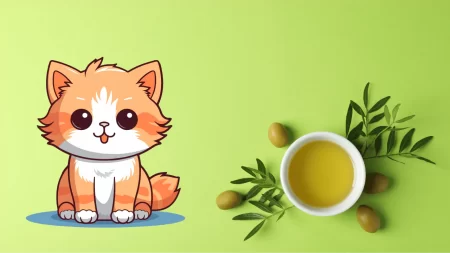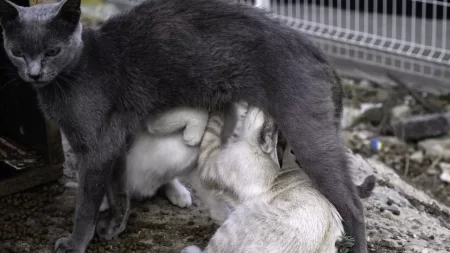Cats can eat dog food sometimes or in emergencies, but not consistently. Cats require more taurine, alanine, and protein than dogs, thus dog food isn’t enough. Taurine deficiency in cats may induce blindness and deadly cardiac problems.
It’s OK for your cat to eat some dog food sometimes, but don’t make it their normal diet. Experts advocate feeding your cat moist cat food to help hydrate them. I hope this clarifies why cats shouldn’t consume dog food.
Why Can’t Cats Eat Dog Food?
Cats and dogs have varied dietary demands owing to evolution and biology. Cats must consume meat and animal fats to live. Dogs are omnivores.
Nutritional differences between cats and dogs
Dog and cat food seem the same, but they contain distinct components and nutrients. Cat food includes more protein than dog food because cats require more protein for muscle building and metabolism. Since cats utilize fat for energy, cat food contains more fat than dog food.
Importance of specific nutrients for cats
Dogs can synthesize or get nutrition from plants, while cats cannot. Taurine, an amino acid, is vital for cats’ hearts, eyesight, digestion, and reproduction. Taurine is exclusively present in animal tissues, thus cats must eat it. Cat food always includes taurine, while dog food may not.
Arginine, another amino acid involved in protein synthesis and detoxification, is another vitamin cats require more than dogs. Arginine is prevalent in animal cells, although dogs may generate some from other amino acids. Arginine must be consumed by cats as they cannot produce it. Ammonia in the blood may kill cats without arginine.
Potential health risks of feeding dog food to cats
If cats eat dog food regularly or exclusively, they will not get enough protein, fat, taurine, arginine, and other nutrients that they need. This can lead to various health problems, such as:
- Muscle loss and weakness
- Weight loss or gain
- Poor coat quality and skin problems
- Dental problems and bad breath
- Anemia and low immunity
- Heart disease and heart failure
- Blindness and eye problems
- Digestive problems and diarrhea
- Urinary tract problems and kidney failure
- Reproductive problems and infertility
- Developmental problems in kittens
Can Cats Eat Dog Food in Small Amounts?
Cats can consume dog food without harm. Cats can eat dog chow, which has calories and nutrients. Do not give cats dog food regularly or as a replacement for cat food.
Short-term effects
If your cat eats dog food occasionally, they may experience some short-term effects, such as:
- Upset stomach and vomiting
- Gas and bloating
- Loose stools or constipation
- Decreased appetite for cat food
- Increased thirst and urination
These effects are usually mild and temporary and will resolve once your cat goes back to eating cat food.
Frequency and portion control
Limit the frequency and amount of dog food treats for cats. Dog food shouldn’t exceed 10% of your cat’s calories. Only offer your cat a tiny quantity of dog food once or twice a week.
Choose a grain-free, high-protein dog food. Avoid cat-harming dog meals with artificial colors, flavors, preservatives, or fillers.
Risks of Long-Term Feeding of Dog Food to Cats
Your cat will acquire nutritional deficits and life-threatening health issues if they consume dog food for more than a few weeks. As indicated, dog food lacks protein, fat, taurine, arginine, and other nutrients cats require.
Nutritional Deficiencies
Taurine insufficiency is the most prevalent nutritional shortfall in dog-fed cats. Dilated cardiomyopathy, in which the heart enlarges and cannot pump blood, may result from taurine insufficiency. Heart failure, lung and abdominal fluid buildup, and abrupt death may result.
Retinal degeneration, which destroys the eye’s light-sensitive layer, may result from the taurine shortage. Blindness, night blindness, or impaired vision may result.
Arginine shortage affects cats who consume dog chow. Hyperammonemia—high blood ammonia levels—can result from arginine insufficiency. Seizures, coma, and death may result.
Protein, fat, vitamin A, vitamin B, and calcium deficits may damage cats who consume dog food. Symptoms include:
- Poor growth and development
- Muscle wasting and weakness
- Anemia and low immunity
- Skin and coat problems
- Bone and joint problems
- Liver and kidney problems
- Nervous system problems
Potential health complications
Besides nutritional deficiencies, feeding dog food to cats can also cause other health complications, such as:
- Obesity and diabetes: Dog food has more carbs than cat food, which may make cats fat and insulin resistant. Obesity and diabetes, lifelong illnesses, may result.
- Urinary tract issues: Dog food has less moisture than cat food, which might dehydrate cats and limit urine production. Urinary tract infections, crystals, stones, and blockages might result. These issues may hurt cats and need surgery or emergency treatment.
- Allergic reactions: Cats may be allergic to beef, chicken, corn, wheat, soy, or dairy in dog food. Cats may respond with itching, scratching, licking, biting, hair loss, skin infections, ear infections, or gastrointestinal issues to these chemicals.
How to Prevent Cats from Eating Dog Food?
If you have cats and dogs, keeping cats from eating dog food may be difficult. Dog food may tempt interested and opportunistic cats. Dogs are less choosy than cats regarding food and may share with their feline buddies.
Dog food is unhealthy for cats, as we’ve seen. Thus, prevent cats from devouring dog food.
1. Separate feeding areas
Separate feedings prevent cats from consuming dog food. You can feed your cat in a separate room or on a higher platform your dog cannot reach. Block the dog food area with a baby gate or door.
After eating, remove leftover dog food. Keep dog food inside. This will prevent your cat from sneaking dog food.
2. Supervise Mealtime
Supervising meals may also prevent cats from consuming dog food. Feed your cat and dog separately or together. Either way, observe them carefully to make sure they don’t swap dishes or steal food.
Praise your cat and dog for eating their own food and discourage them from eating each other’s. Reward excellent behavior with food or toys.
3. Choose Appropriate Cat Food
Your cat might consume dog food if it finds its own cat food less palatable. As a solution, selecting cat food suitable for your cat’s age, dimensions, activity level, health status, and tastes becomes vital.
You should opt for a cat food variant designed to nourish your cat in its specific life stage, be it a kitten, adult, or senior. High-quality animal protein should lead the list of ingredients in your chosen cat food, examples being chicken, turkey, or fish. Besides, the food should contain balanced animal fat like chicken fat and low carbohydrate contents like rice, not forgetting the addition of taurine and other essential nutrients.
Bear in mind your cat’s food preferences while picking cat food. Cats may have a liking for wet cat food over dry variants, or the other way around. Similarly, some cats may have a distinct preference for certain flavors or textures. Experimenting with different brands or kinds of cat food until you discover your cat’s favorite may be necessary.
4. Offer Alternative Treats or Snacks
Bored or hungry cats may consume dog chow. Therefore, provide them with cat-friendly goodies. Give your cat catnip, cat grass, tuna, salmon, chicken, or cheese treats. These treats help keep your cat away from dog food and give additional nutrition and excitement.
Do not overfeed your cat cookies or snacks. Cat treats should not exceed 10% of their daily calories. Avoid treats with artificial colors, flavors, preservatives, or fillers.
5. Training and Behavior Modification
Training cats to avoid dog food is the final option. Use positive and negative reinforcement to educate your cat to avoid dog food.
Positive reinforcement rewards cats for good behavior like eating their own food or not devouring dog food. Reward with gifts, toys, praise, or love. Negative reinforcement discourages cat misbehavior like devouring dog food or stealing from the dog’s dish. Deterrents include loud noises, spray bottles, claps, and severe voices.
Cat training requires consistency and patience. Your cat may need to be taught and practiced. Punishing your cat physically or verbally may produce fear, tension, or hostility.







